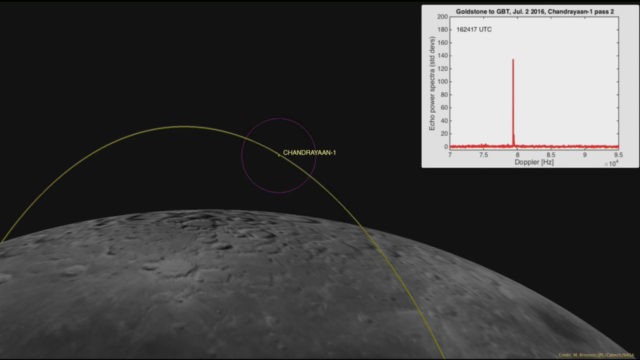NASA has tracked down a lost Indian lunar probe that last had contact with Earth in 2009 by using a new microwave radar detection system to follow its orbit around the moon.
The Chandrayaan-1 lunar orbiter, a 5-foot by 5-foot cubical craft, studied the moon from October 2008 through to August 2009. It launched an onboard impactor into the moon shortly after orbit, revealing evidence of water in the form of ice on the moon’s surface. However, the craft then lost contact with the Indian Space Research Organisation, and its location remained unknown until NASA picked it up.
Researchers at NASA’s Goldstone Deep Space Communications Complex in California sent a powerful beam of microwaves towards the moon from their 270-foot antenna in July 2016, with the beams that bounced back to Earth received by the Green Bank Telescope in West Virginia.
It turns out the Chandrayaan-1 was pretty much where the teams at NASA expected it to be, despite the moon being covered with “mascons,” the technical term for areas on the lunar service which have a higher gravitational pull, such as mountains. These can dramatically affect the orbit of probes, but did not drastically alter the path of Chandrayaan-1.
Those searching for the craft utilized their knowledge that the probe should be in a polar orbit, always crossing above both the north and south poles of the moon. Something with the velocity, size and predicted orbit of Chandrayaan-1 was then picked up by the radar detectors.
Ryan Park, the manager of the Solar System Dynamics Group at NASA’s Jet Propulsion Laboratory in Pasadena and a member of the detection team, said in a statement that in order to find Chandrayaan-1, they had to shift its location “by about 180 degrees, or half a cycle from the old orbital estimates from 2009. But otherwise, its orbit still had the shape and alignment that we expected.”
NASA was not only able to pick out Chandrayaan-1, but also their own Lunar Reconnaissance Orbiter, or LRO. This was not as much of a challenge, as it is still an active craft. Marina Brozovic from JPL in Pasadena said that finding the LRO was “relatively easy, as we were working with the mission’s navigators and had precise orbit data where it was located.”
According to a statement from NASA officials on the mission, these new ground-based radar systems could be used “in both future robotic and human missions to the moon, both for a collisional hazard assessment tool and as a safety mechanism for spacecraft that encounter navigation or communication issues.”
Jack Hadfield is a student at the University of Warwick and a regular contributor to Breitbart Tech. You can follow him on Twitter @ToryBastard_ or on Gab @JH.

COMMENTS
Please let us know if you're having issues with commenting.